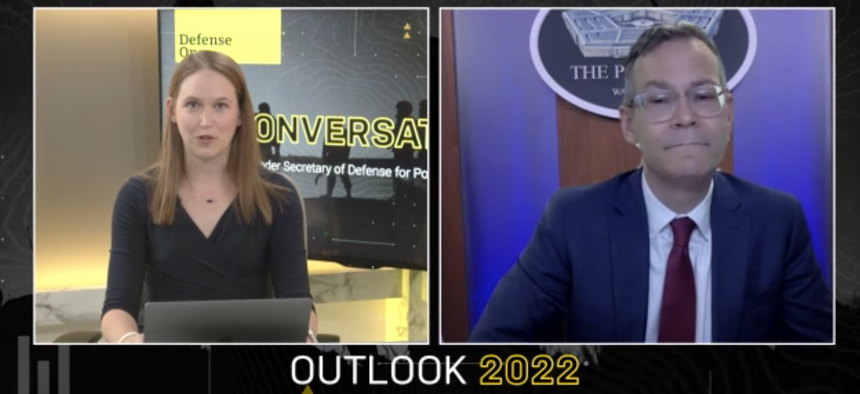
Defense Undersecretary Colin Kahl, right, speaks to Defense One's Jacqueline Feldscher during Outlook 2022.
New National Defense Strategy to Be Released Early 2022
The Pentagon's NDS will follow the release of a new National Security Strategy from the White House, officials said.
A new National Defense Strategy is expected to be released early next year following the release of the other strategic documents, the Pentagon’s top policy official said Wednesday.
“We have a number of strategic reviews underway all at the same time. We have the National Defense Strategy, and then nested under that will be the Nuclear Posture Review and the Missile Defense Review. And of course, the NDS itself is nested under the National Security Strategy. So, I think we should expect that the National Security Strategy will come out first, shortly followed by the NDS. I would hope that we would see that early in the new year,” said Colin Kahl, defense undersecretary for policy, at Defense One’s Outlook 2022 conference.
"We're going to get a National Security Strategy," Jake Sullivan, President Joe Biden's national security advisor, said in an exclusive interview with Defense One on Wednesday, just before Kahl's appearance at the same event. "I'm not going to speculate as to a date." Biden’s administration released an Interim National Security Strategic Guidance document in March.
The current National Defense Strategy dates to 2018. Released by former Defense Secretary Jim Mattis under President Donald Trump, it announced a pivot toward great power competition with China, Russia and other adversarial states.
The Pentagon finalized the Global Posture Review on Nov. 29, ahead of a new National Defense Strategy and National Security Strategy, because the White House tasked the department to provide it sooner, Kahl said. The posture review will informs the upcoming NDS, which will then inform future posture decisions, Kahl asserted.
“All these things are living frameworks,” he said.
Kahl pushed back on criticism of the Global Posture Review and the expectation that it would provide major strategic shifts as DOD pivots towards great power competition, especially in the Indo-Pacific region. The review is classified and the Pentagon released only a statement and held a news conference to describe its contents.
“I understand the criticism, but I think it fundamentally misunderstands the purpose of the document. The purpose of the document was not to define our global posture for all time. Instead, it's largely a strategic framing and disciplining document. It's meant to provide a structure around which the department can prioritize not only our current posture, but the posture decisions we make in the months and years ahead,” he said.
Kahl argued that under Biden the Defense Department had undertaken “major muscle movements” in the Indo-Pacific region, which the posture review identifies as the priority theater.
“We announced rotational fighter and bomber deployments to Australia. That kind of got lost in all the other news about AUKUS, but it's a big deal,” he said. “Meanwhile, we're making investments and improving our infrastructure in places like Japan, Guam, and the Pacific Islands and in Australia.”
Other posture review-related decisions include permanently stationing a previously rotational attack helicopter squadron and an artillery division headquarters in the Republic of Korea as well as improvements to shipyards in Guam and other regional locations.





